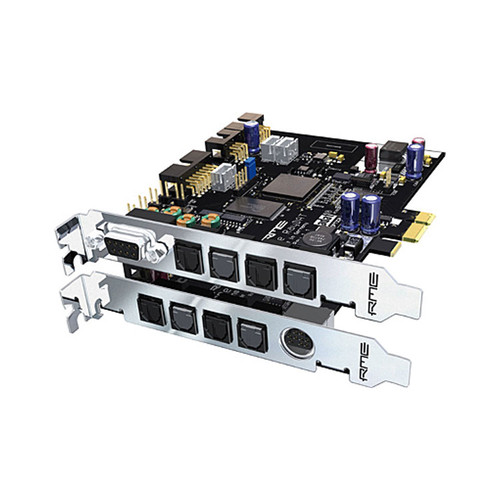Micstasy is an 8-Channel hi-end mic/line preamp and AD-converter combining typical RME features with a number of previously unseen features. It can be used analog (Mic/Line In to Line Out) and digital (Mic/Line In to Digital Out), with both signal paths operating simultaneously. Special highlight: the device is fully remote-controllable via MIDI (also MIDI over MADI).
The Micstasy's innovative concept allows for amplification and digitization of ALL analog signal sources. Be it high level stage signals, typical studio signals, lower level and high impedance instruments, or dynamic, condenser or ribbon microphones: Micstasy understands them all in a way that is simply thrilling.
The signals amplified by the Micstasy are available at the analog outputs for passing them on, making an expensive splitter box on stage obsolete. All functions can be remote controlled via MIDI and MIDI over MADI, allowing the device to be placed near the microphones, ensuring highest sound quality.
Adding the optional MADI Card results in even more options. The I64 MADI Card provides serial pass-through capability from one Micstasy to the next (up to 8). All up to 64 audio signals are then available at the last device on one single line. Such a way of cascading is also possible between Micstasy and ADI-8 QS.
RME Micstasy Features
- 8 balanced XLR mic/line inputs with 85 dB gain range
- Analog input level from -56.5 dBu up to +30 dBu
- High-end circuitry with 4 relays per channel, super low-noise microphone front-end
- Near click-free gain changes in steps of 0.5 dB
- Large frequency range (200 kHz) with special EMI input filtering
- 8 balanced TRS line / instrument inputs with Hi-Z option
- 8 balanced XLR line outputs, maximum level +27 dBu
- 4 x AES/EBU Out via D-sub, 8 channels @ 192 kHz
- 2 x ADAT Out, 8 channels @ 96 kHz (SMUX and SMUX4)
- Optional MADI I/O (I64 MADI Card) with serial cascading and digital return path
- Symmetrical hi-pass (Lo Cut) with super-low THD, 18 dB/oct
- LED level meter with 13 LEDs per channel
- M/S de-/encoding for the digital output
- AutoSet: Automatic gain reduction with multiple linking
- Current state can be stored to 8 user presets
- Fully remote controllable
- RME Micstasy Additional Features
- In a standard 19" box with 2 unit height the device offers numerous extraordinary features like Intelligent Clock Control (ICC), SyncCheck, SteadyClock, TotalGain, AutoSet, MIDI over MADI, and remote control via MADI and MIDI.
The technologies known from other RME products like SyncCheck ensure perfect synchronization and clear detection of errors. Also multiple units can be stacked and operated sample aligned, using word clock. All settings are stored when the unit is switched off.
The Micstasy can be fully remote controlled and configured via MIDI, and all status displays can be queried through MIDI. Each Micstasy can be given a separate ID, allowing separate remote controllability of various devices with only one MIDI channel. The MIDI remote is also compatible to Digidesign's Pro Tools system, Yamaha's M7C and PM5D. The manual further shows how to remote control the Micstasy from the DM-1000 and DM-2000.
RME's SteadyClock(TM) guarantees excellent clock quality in any situation. Due to the highly efficient jitter reduction, the Micstasy's AD-converters operate independently from the quality of the external clock signal, as if they are working with internal clock all the time - guaranteeing a prestine sound quality! Additionally Intelligent Clock Control (ICC) will retain the last valid sample frequency in case of a loss of the input signal.
RME Micstasy Low Latency
In the Micstasy RME uses high-class AD-converters from Cirrus Logic, offering exceptional Signal to Noise and distortion figures. But the biggest difference to all other ADCs out there is its innovative digital filter, achieving for the first time a delay of only 12 samples in Single Speed 0.25 ms), 9 samples in Double Speed 0.09 ms), and 5 (!) samples in Quad Speed (0.026 ms).
These values are less than a quarter of those available from even much more expensive devices. They represent an important step in further reducing the latency in the computer-based recording studio. At DS and QS the added latency can simply be ignored. And with the ADI-8 QS, a matching DA-converter with only 5 up to 10 samples delay will turn 'analog digital monitoring' into real analog-style monitoring.
RME Micstasy AutoSet
Some preamps include limiters in order to prevent clipping, especially of the A/D converter stage. Such a circuitry is not feasible for the Micstasy, because it would spoil the mic preamp's excellent technical specifications.
But as the Micstasy's gain is controlled completely digitally, the device can set it automatically, thus providing perfect protection from overload with no degradation of the audio signal, which does not have to pass any additional electronic circuitry.
In the Setup menu, the threshold level beyond which the gain will be reduced can be adjusted in four steps (-1, -3, -6, -12 dBFS). Any change of gain will be shown immediately on the GAIN displays. And with AutoSet activated, the gain can still be changed manually.
RME Micstasy I64 MADI Card
The I64 MADI Card provides the Micstasy with a 64-Channel MADI input and output. Coaxial and optical output operate in parallel to the AES/EBU and ADAT output, therefore deliver the same data.
The I64 MADI Card features an optical as well as a coaxial MADI input. The input is switched automatically, according to where a valid input signal is detected. Full redundancy is ensured by the automatic input switching, immediately changing to the other input in case of loss of the input signal.
The MADI input will operate as an optional clock source (Clock section, OPTN) as well as a thru-input. Since each Micstasy uses only 8 channels, up to 56 channels can be passed through. This technique is used to serially cascade several Micstasys. Incoming MADI data is passed through unchanged, only one block of eight channels is replaced. This allows up to 8 devices to be connected serially. All 64 combined channels are available at the last device's MADI output.
With an installed I64 MADI Card the Micstasy can be remote controlled via MADI. At the same time MIDI data are transmitted via MADI.
When multiple devices are connected serially, the MADI I/O of each Micstasy causes a delay of 3 samples. Therefore at the MADI output of the last device, the data of all upstreamed devices are delayed. The problem of this offset is solved by the function Delay Compensation.
Using the I64 MADI Card provides the ability of 8 channels being used as digital return path, sending audio via MADI to the Micstasy's ADAT and AES outputs. For example stage and studio monitors can be fed digitally from the Micstasy. On stage the use of an additional D/A-converter (e.g. ADI-8 DS might be necessary. The MADI output continues to carry the analog input signals and the fed-through input data.
RME Micstasy Tech Specifications
- Frequency response -0.1 dB: 20 Hz - 100 kHz
- EIN @ 30 dB Gain @ 150 Ohm: 122.3 dBu
- EIN @ 40 dB Gain @ 150 Ohm: 126.5 dBu
- EIN @ 50/60/70 dB Gain @ 150 Ohm: 127.4 dBu
- THD+N @ 30 dB Gain: < -100 dB, < 0.001 %
- Signal to Noise ratio AD (SNR) @ +30 dBu: 115.2 dB RMS unweighted, 118.5 dBA
- Signal to Noise ratio AD (SNR) @ +21 dBu: 112.7 dB RMS unweighted, 116 dBA
- Signal to Noise ratio AD (SNR) @ +13 dBu: 110 dB RMS unweighted, 113 dBA
- Sync sources: Internal, AES, word, Option (MADI)
- Sample frequencies: 44.1 kHz, 48 kHz, 88.2 kHz, 96 kHz, 176.4 kHz, 192 kHz, variable (external clocks)
- Sample rate range: MADI: 32 - 192 kHz, word clock: 27 kHz - 200 kHz, AES: 28 kHz - 200 kHz
- Jitter: Typical < 1 ns for internal, word clock, AES and MADI input
- Jitter suppression: >30 dB (2.4 kHz)
- Jitter sensitivity: all PLLs operate error-free even at 100 ns
- Power supply: Internal switching mode PS, 100V - 240V AC, 60 Watt
- Dimensions: (WxHxD) 483 x 88 x 200 mm
- Warranty: 2 years
RME Micstasy Connectivity
- 8 x Analog Input Preamps (XLR/Line with 85 dB gain range)
- 8 x Analog Output (XLR)
- 4 x AES/EBU Out (8 channels @ 192 kHz)
- 2 x ADAT Out (SMUX and SMUX4)
- MIDI I/O
- Word clock I/O
- Optional: MADI I/O (I 64 MADI Card)












